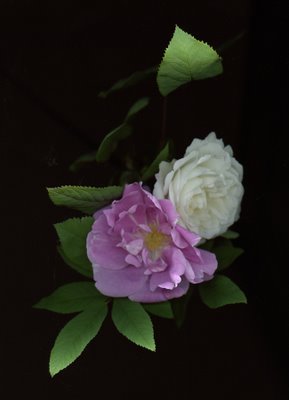The Russian, The Frenchman, The Canadian & The Placid Italian Via England
Wednesday, June 04, 2008

I must confess that in the almost 80 roses in my garden only one of them is a Canadian rose. It is Rosa 'Thérèse Bugnet'. She is usually the third rose (the first and second) to bloom in spring. Such was the case this year but she shared the honour with the English rose Rosa 'Fair Bianca' which happens to be my favourite rose of the garden because of her complex and special myrrh scent.
Thérèse Bugnet is a tall rose. She is 10ft high and one of her most attractive features is that the new canes are all wine red. The blooms are semi double, clear red, fading to pink and extremely fragrant. Because of its rugosa heritage (roses that originally came from Northern Japan, Korea and Siberia) she is hardy to Zone 2. This means she would grow just fine in Yellowknife.
And that would have been that and the only excuse for today's blog to post my scan of the two roses. I did the scan around three today. But I have always been curious about the name. Who was Thérèse Bugnet? My rose bible, Peter Beales - Classic Roses simply says:
Bugnet - Canada 1950.
Further enquiry led me to find out that Georges Bugnet had lived in Alberta and that he died at age 101. But he was far more complex and much more interesting than I could have imagined. The rose which was crossed from a Russian rose and an Alberta wild rose is 'Thérèse Bugnet'. Bugnet named the rose after his sister.
So here you have a Canadian rose bred by a Frenchman (in Northern Alberta) from a Russian rugosa next to an English rose named after the more placid sister of Shakespeare's shrew.






